Cervical back pain is a certain dystrophic changes of the intervertebral discs in the neck area.
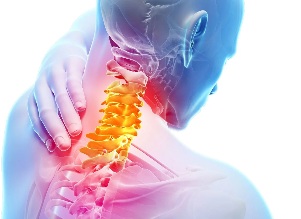
Negative effects are not only themselves the discs and the vertebrae, soft cartilage. The main feature of the cervical spine is the fact that the vertebrae have not been the most reliable construction in comparison with other parts, which makes this area very vulnerable. The vertebrae here are very close to each other, as well as in those of the arteries, involved in the nutrition of the human brain.
If that is the displacement of vertebrae, then there is a great chance to break the nervous beams and of the arteries, which inevitably force you to move to the appearance of a hernia between vertebrae and overhang, ie. change in the structure of the vertebral disc.
What is this?
Osteochondrosis of the cervical spine (Osteohondroz) is a degenerative-dystrophic lesions of the intervertebral discs, which had as a result of to be destroyed the same the discs, the vertebrae and the joints of the cervical spine, there is a decrease in the height of the intervertebral disc. The disease progresses, if not treated, and can cause headaches, disorder of blood circulation, and even hernia. Like osteoporosis, the disease is caused by disorders of the mineral metabolism, with the result that the bones and joints become less durable.
Osteochondrosis can cause instability of the cervical spine (the symptoms and the treatment is similar to with chondrosis, but they have a number of features), which is often accompanied by displacement of the vertebrae. In turn, accelerate the development of degenerative disc disease, destroying part of the spine.
Stage
The treating physician should identify the degree of development of cervical degenerative disc disease, based on the story, as well as carrying out an inspection of the patient. There are just four points:
- The first degree. The disease is in the Bud, the patient observed a small pain in the neck, which may be more pronounced, if the person begins to turn his head.
- Second degree. The patient may complain of very severe pain in the cervical section, which can be found in the upper extremities. The clinical picture shows that in this stage of development of the disease there is a pinched nerve beams, what and causes intense pain. It is also noted headache, weakness and general malaise.
- Third-degree. Pain are almost underway, and giving the shoulder or arm. Some patients diagnosed with herniated intervertebral disc, leading to loss of sensation of the upper extremities. During the examination the physician observed a significant reduction in the mobility of the cervical spine, as well as pain during palpation.
- Fourth grade. At this stage of the disease the intervertebral disc is almost completely destroyed. In place occurs connective tissue, leading to worsening of the patient's condition. Starts stronger feel the pain, the noise in the head, and poor orientation in space. This suggests that the artery is demonstrated pinched, what prevents the natural food of the brain.
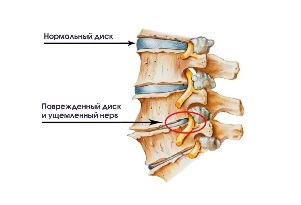
The symptoms of degenerative disc disease of the cervical spine of the
Significantly the symptoms of degenerative disc disease of the cervical spine are dizziness, headache, drop in blood pressure.
The diagnosis of the disease is difficult, with the pain sometimes does not manifest itself, and symptomatology brings deleted character, moreover, the uncontrolled use of strong analgesics hides the signs of the disease. The patient, does not believe in pain, he considers himself healthy, and so continued until the development of irreversible processes in the tissues of the joints of the neck.
Headache when cervical osteochondrosis.
This is one of the most common non-specific symptoms of many human diseases. The headaches are especially prevalent in the female population. It is difficult to determine the cause of headaches, and, even more, to be connected with lesions of the spine. They have identified about 14 different reasons for headache in humans.
The most common causes of headaches, when described our pathology:
- Spasms of the blood vessels of the brain?
- Pinched the roots of the nerves;
- Reflex increase in intracranial pressure.
Headache when cervical osteochondrosis. it may look like the feeling when arterial hypertension, angina pectoris, or stroke. Moreover, in people middle-aged and older, as a rule, there are risks of developing strokes or heart attacks.
It feels like the pain may be paroxysmal, permanent, pulsating and stupid.
When pathologies of the heart, the patients complain of discomfort in the chest area, accompanied by a disorder of the heart's rhythm. To determine the cause may only qualified doctor. In case of occurrence of headaches, along with nausea, dizziness and substernal pain, be sure to ECG.
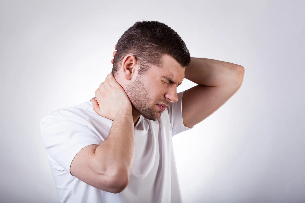
Dizziness during cervical osteochondrosis.
This situation is not always clearly shows osteochondrosis of the cervical spine.
Dizziness can be caused by:
- Inflammation of the average or internal ear?
- Spasms of the vessels of the brain?
- Disorders of the transmission of nerve impulses;
- Problems with stomach machine?
- Diseases of the cardiovascular system.
There are no clear criteria vertigo during osteochondrosis. However, there are system and non-systemic vertigo, have clear differences.
It is recommended to be aware of the differences and non-vertigo, that will help yourself to identify the cause vanish of the situation:
- System dizziness is a sense of circular motion around objects or of the body, which is a consequence of the disruption of the vestibular apparatus, optical devices and analysis of receptors in joints, muscles, and skin (osteochondrosis of different etiology);
- The system is not vertigo is a feeling of faintness, feeling of stun, you are not sure the situation is in the upright position. When non-system dizziness sense of circular rotation is missing, and that's a significant difference in terms of signs.
The man thinks dizziness one of these forms must be treated by an experienced doctor in the first place, neurologist or (if there is a suspicion of disease of the ear and throat) otolaryngologists.
The reason for urgent hospitalization, is not associated with οςτεομε chondrosis cervical spine, is the recognition of the patients (apart from dizziness) like symptoms, such as:
- Paralysis of the muscles of the face and numbness of part of the ohmic zone?
- Strong headache in the background of the deterioration of health?
- Violation coordinate movements?
- Loss or alienation of consciousness.
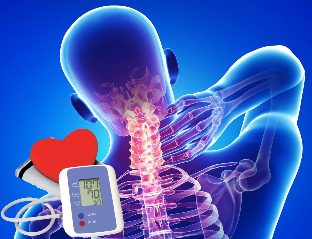
The blood pressure in the cervical osteochondrosis.
Communication cervical degenerative disc disease with abnormal blood pressure and long has been installed. Cervical vertebrae have significant nerve endings and blood vessels.
It is characterized by pressure drop during the day. Hypertension for a long period of time is not typical for this disease. Reflex irritation of the nerve endings and intermittent spasms of the blood vessels causing hopping next dynamic arterial hypertension.
The special feature of the high pressure of the blood when the cervical osteochondrosis. it's a combination of the following symptoms:
- Headache?
- Pain in the extremities and the chest?
- Reduction of the sensitivity in the region of neck area?
- Show jumping type, after stress, muscle tension, prolonged stay in an uncomfortable posture, and other similar situations.
These signs should be taken into account in the self-modulation hypertension of different genesis.
Steep HELL and the rapid deterioration of health are the basis for calls for emergency medical assistance.
Syndromes of degenerative disc disease.
The clinical picture of cervical degenerative disc disease is applied to various syndromes. Syndrome are some of the symptoms that you experience together.
Osteochondrosis is composed of the following syndromes:
- Spine. It is also called spinal, indicating that the disease process involved bones and cartilage. This leads to the formation of these symptoms: limitation of motor activity neck pain during the turns, radiographic changes in the image of the cervical spine. Is the simultaneous appearance of these symptoms is spinal syndrome. Similar to the set of clinical symptoms is observed myositis (pathology of muscle tissue), as well as painful movements companion of many other diseases.
- Syndrome vertebral artery. Occurs during the participation in the process of vascular bundles, which are responsible for the perfusion of the tissues of the central nervous system. The symptoms indicate that the fabric of the brain have stopped receiving the proper amount of nutrients. How to recognise this syndrome? First symptoms are dizziness, feeling of noise in the ear, fluctuations in blood pressure, the appearance of the "shroud" in front of my eyes. This suggests that one of the vertebrates of the arteries is stavlennia situation. Each ship has its own nerve endings. If you push the sides of the container, those that innervate the vertebral artery will appear migraine, numbness, transient loss of vision on one side. Finally, the changes in vessels lead to the fact that the brain needs oxygen. In that time the person feels sleepy, short-term disorders of consciousness, loses attention and control, it works worse, and stores the information. When the clinical picture must be differentiated cervical back pain with atherosclerosis vertebral arteries, and compression of tumor or inflammation.
- Hyperactive syndrome. It manifests itself with a burning sensation in the chest area,the appearance of shortness of breath. The man feels the frequent heartbeat, it becomes tired and irritable. This picture is characteristic and for pathology and cardiology, for example, for angina, coronary syndrome, heart attack. Accurate conclusion about the causes of these symptoms can be done, since the patient ECG.
- Radicular syndrome. Cervical part innervates 8 pairs of nerves, each of which has its roots place of production of the nerve by vertebra. During their involvement in osteochondrosis, the patient feels a decrease in the sensitivity or the inverse of intense pain. It can be observed numbness of the neck if the pain, reduce the sensitivity of the language, BTE region, pain in the supraclavicular area. Sometimes there are disturbances of swallowing, movements in the zone of upper extremities, numbness of the fingers of the hand.
The first aid at home when acute and degenerative disc disease.
In severe bolevom syndrome can be used pain medications, such as Analgin, Tempalgin, or Baralgin. If the above medicines do not bring relief, it can take NSAIDS (nice, uh, or Diclofenac).
Often used "distractions" in, for example, the pepper Spray patch, not a cure, but only blowing from the irritated area and distract from the pain. In the case of education of the swelling in the area of inflammation, the patient may drink infusion of herbs or diuretic during 3-4 days. We can cure osteochondrosis such methods? These measures are only temporary, for the treatment of the grounds should consult a doctor.
It should be noted, what the doctor is treating osteochondrosis. If you suspect, that the cause of pain in the cervical spine is the appearance of degenerative disc disease, you should consult a neurologist. This specialist deals with diseases of this kind. In some sanatoria there are narrow specialists who deal with diseases of the spine. If your clinic, there are a spine, you should contact with the question of how to cure this disease, immediately to him.
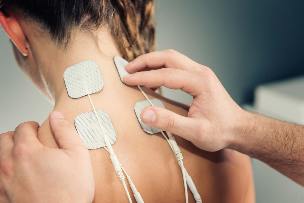
How to treat osteochondrosis of the cervical section?
In the initial stage of development cure the back pain without drugs, it is enough to revise diet, day mode, perform regularly in the specific exercises. In advanced forms of the disease effective treatment is possible only under the condition of application of the various drugs that help to inhibit degenerative changes in a vertebrae.
In the complex treatment necessary include physiotherapy – electrophoresis with drugs, ultrasound, magnetic therapy, laser therapy. These techniques help to deal with the pain, inflammation, edema of tissues, improves the processes of exchange and the circulation of the blood.
Drug therapy
The main methods of treatment is osteoarthritis of the cervical spine is the medication, physical therapy, massage cervicofacial neck region, particularly effective therapeutic exercise in cervical osteochondrosis.. The basic groups of medicines used in this disease, refer to:
| Name | The principle of action |
| Non-steroidal anti-inflammatory drugs (NSAIDS). Voltaren emulgel, nuys, uh, meloxicam, ketonal, Ketanov, diclofenac, nimesulide and other | Reduces pain syndrome, contribute to the relief of aseptic inflammation and edema of the root of the damaged nerve. |
| Drugs that improve the flow properties of blood and the flow of blood. Is aminophylline, trental. | Improve the nutrition of the damaged nerve roots and improves the circulation of blood to the brain brain. |
| B-complex vitamins, it Is combilipen, unigame, milgamma, neurobion. | It improves the metabolic processes in the nervous tissue. |
| Muscle relaxants. It's mydocalm, sirdalud, cut, tizanidine, etc. | Are drugs, relieving spasm of the muscle. |
| Chondroprotectors. This (glucosamine and chondroitin) artra, terafleks, doppel'gerc, frog stone, Andronova, structovis, alflutop. | It's medicinal, rejuvenating of cartilage fabric, including in a damaged intervertebral disc. |
Taking pills from degenerative disc disease, you have to remember that one important outcome from the drug therapy the tablets will be only in case, if you combine it with other methods, including exercise. Also it should be noted that the attending doctor must prescribe the treatment of the disease based on the stage, and other symptoms.














































